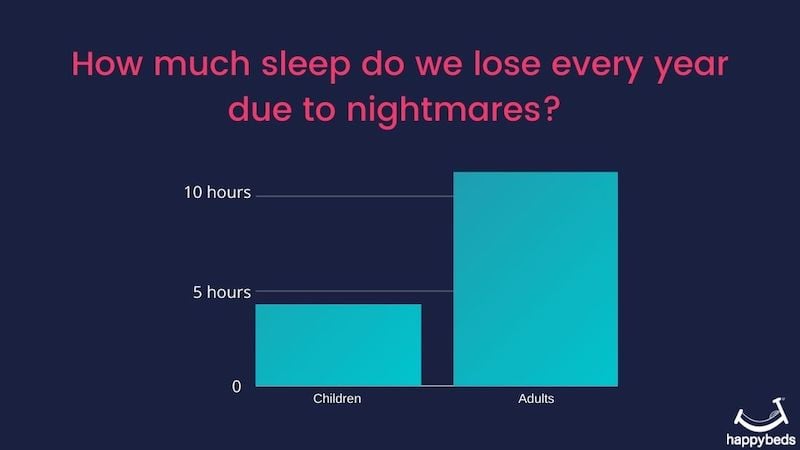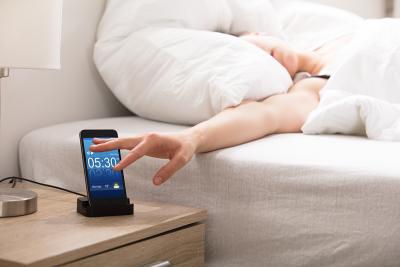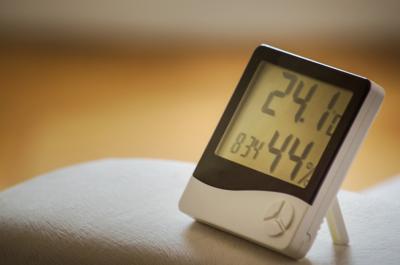Have you ever had trouble falling back to sleep after a nightmare? Well, you’re not alone. We’ve surveyed 2,000 adults and found that both adults and children lose sleep because of nightmares – perhaps more than you’d think.
So, what types of nightmare are we having and what does this mean for our quality of sleep? Keep reading to find out what we learned.
How Do Nightmares Affect Your Sleep?

Our survey has revealed that on average, it takes children 21 minutes to fall back asleep after a bad dream. For adults, it takes even longer – 28 minutes on average. This might not sound too bad but for someone who regularly suffers from nightmares, the time soon adds up.
We spoke to counselling psychologist, Dr Susie Dawson for some tips on how parents can help their children get back to sleep when waking from a nightmare. She says:
“Going to bed late and being over tired are known triggers for nightmares in children. Parents and carers can help prevent nightmares by establishing a calming bedtime routine which can include going to bed at regular time and pre-bed activities such as watching stars through the window, taking a bath and having a warm milky drink.
Electronics emitting blue light can inhibit production of the sleep-inducing hormone melatonin, ideally tablets/mobile phones should be switched off at least 30 minutes before going to bed.
It is best not to watch scary movies at night; instead try spending time together thinking about what made a child feel happy during the day, which helps support a relaxed state of mind and reduce threat responses.”
Read More: Dealing with Nightmares: A Psychologist Reveals How to Beat Recurring Bad Dreams
What’s the Big Picture?

Children have nightmares roughly once a month, and for adults the average is once every two weeks. This means children miss out on over four hours of sleep every year due to nightmares alone – and adults lose a whopping 11.2 hours of sleep for the same reason.
Our survey also showed that our night-time fears are affecting us in other ways: one in six people said they’re scared of the dark, a third of respondents said that sleeping with a partner makes them feel safer, and over a fifth of adults (22%) said they sleep with a light on. You might want to think twice about bedside lights, though, as we have also found that keeping just one light on for 8 hours every night will cost an individual over £52 a year.
When combined, this equates to £1.6m each night and a massive £588.6 million each year. However, if the UK were to switch from incandescent lightbulbs to LED, this would take the annual figure down to just £268.6k, saving the UK £1.3m per year.
Read more: Are Night Lights Bad for Sleep?
What Types of Nightmares are Most Common?

As you might have guessed, our little ones aren’t haunted by the same bad dreams we are. The most common nightmares for adults tend to be about real-world concerns and issues. Common themes include:
- Death
- Family
- Abandonment
- Relationships
For children, nightmares are more imaginative and otherworldly. The top nightmares for children include:
- Monsters
- Zombies
- Animals
- Witches
How to Fall Asleep After a Nightmare
Nightmares can evoke feelings of panic, anxiety, sadness and sometimes grief. Even after waking, it can be difficult to know how to shake off a bad dream and drift back into a restful state. So, how can you limit the amount of sleep you miss out on? Here are our top recommendations for what to do after a nightmare:
- Avoid looking at the clock – reminding yourself of the time can add to your stress.
- Try deep breathing – focus yourself and take slow breaths to regain your calm.
- Drink water – take a quick water break to help yourself settle.
- Listen to music – low, calming music can help you drift back to sleep.
- Change location – if all else fails, switching rooms can help put some space between you and your bad dreams.
If you would like to learn more about bad dreams and their triggers, please read our post: What Causes Nightmares and How Do You Stop Them?
Make Sure Your Bed Isn’t a Nightmare, Too!
One thing that might help your child get to sleep is an exciting new kids bed. Happy Beds sell a great range of kids beds and this will be sure to help keep nightmares away!













